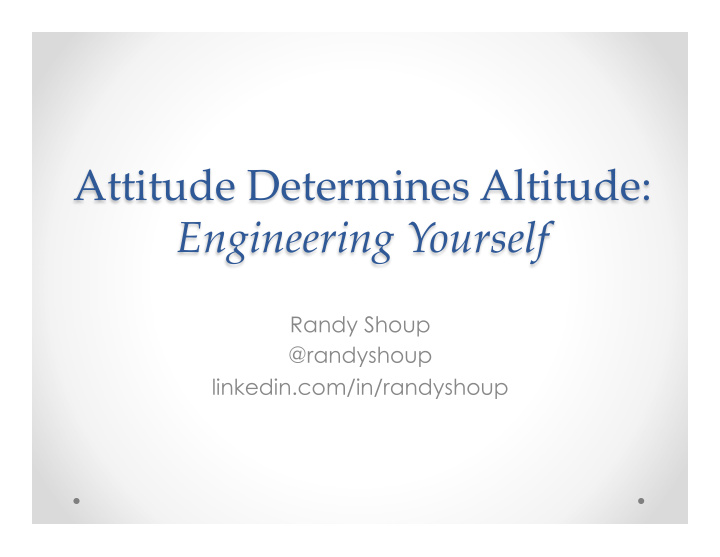



Attitude Determines Altitude: Engineering Yourself Randy Shoup @randyshoup linkedin.com/in/randyshoup
http://travellingmoods.com/wp-content/uploads/2015/02/Mount-Everest1370207712.jpg
About Me Swiss-German / Catholic roots Grew up in the SF Bay Area Attended private high school Studied Political Science / Mathematical and Computational 15 Million Science at Stanford Studied abroad in West Berlin and Kraków
From International Law to Software Engineering High school debater Passionate about East-West relations and arms control Entered joint JD / MA program at 15 Million Stanford Law School and SAIS Discovered I loved software more!
Software Engineering Chief Engineer at eBay Engineering Director at Google 15 Million VP Engineering at Stitch Fix VP Engineering at WeWork
Also About Me Child of divorced parents, raised by single mom Financial need / work-study scholarship at every school I ever attended 15 Million Divorced Single dad
“ Nicht geschimpft ist genug gelobt ”
“Lack of complaint is praise enough”
Growth Mindset Trust Confidence
Growth Spectrum I know I I am never I cannot can good get better improve enough
The Growth Mindset • Dr. Carol Dweck of Stanford • Your self-theory about intelligence and talent determines your learning achievement, skill acquisition, professional success • Most effective way to improve is to know that you can
Fixed vs. Growth Mindset Fixed Mindset Growth Mindset Talent is static Talent can be developed Leads to a desire to look smart and Leads to a desire to learn and therefore a therefore a tendency to … tendency to … Avoid challenges Embrace challenges Give up easily due to obstacles Persist despite obstacles See effort as fruitless See effort as path to mastery Ignore useful feedback Learn from criticism Be threatened by others’ success Be inspired by others’ success
The 10,000 Hour Rule • “Ten thousand hours is the magic number of greatness.” • Deliberate practice with constant challenge
“Practice isn’t the thing you do once you’re good. It’s the thing you do that makes you good.” – Malcolm Gladwell, Outliers
Focus and Attention • Psychologist Daniel Goleman, 2013 • Ability to focus (“ cognitive control ”) is the best predictor of success and high achievement
Focus and Attention Focus is the ability to moderate between two parts of the brain: • Top-down higher brain o Neocortex o Executive function o Deliberative, reflective, self-aware • Bottom-up lower brain o Amygdala o Emotion and motivation o Impulsive, uncontrolled
Focus and Attention Complex interplay between Creativity and Execution: • Creativity from “open awareness” o Daydreaming o Finding unexpected connections • Execution from focus o Goal focus o Resistance to distraction
Attention is a “Mental Muscle” “From the perspective of cognitive science, all meditation methods are methods to train attention.” – Daniel Goleman
“It’s not that I’m so smart; it’s just that I stay with problems longer.”
Richard G Shoup (1943-2015) PhD in Computer Science, Carnegie Mellon University 1970 Proposed programmable logic chips (aka FPGAs) Pioneered computer graphics at 15 Million Xerox PARC at age 30 Won Emmy and Academy Awards for SuperPaint system Professional-level jazz trombonist https://en.wikipedia.org/wiki/Richard_Shoup_(programmer)
William K Reilly (1940-) BA Yale, LLB Harvard Law, MUP Columbia Fluent in French President and Chairman of World 15 Million Wildlife Fund Appointed EPA Administrator by President George W Bush Appointed Chair of Gulf Oil Spill Commission by President Obama https://en.wikipedia.org/wiki/William_K._Reilly
HAPPINESS EQUALS HAPPINESS EQUALS REALITY MINUS REALITY MINUS EXPECTATIONS EXPECTATIONS. – Tom Magliozzi, Car Talk
Trust Spectrum Trust Naïveté Distrust
Theory X vs. Theory Y • Dr. Douglas McGregor, 1960 • Leadership’s beliefs about what motivates employees
Theory X vs. Theory Y • Theory X : people are inherently lazy and avoid responsibility, require extrinsic motivation • Theory Y : people are intrinsically motivated, seek ownership, want to perform well
Westrum Organizational Model • Generative Organization o Trust and Sharing • Bureaucratic Organization o Rules and Processes • Pathological Organization o Fear and Threat
Psychological Safety • Team is safe for interpersonal risk-taking • “Being able to show and employ one’s self without fear of negative consequences” • More important than any other factor in team success
“If you can’t change your organization, change your organization.” – Martin Fowler
Confidence Spectrum Confidence Fear Arrogance
“Whether you think that you can or you can’t, you are usually right.” – Henry Ford
“Despite outstanding academic and professional achievements, women who experience the Impostor Phenomenon persist in believing that they are really not bright and have fooled anyone who thinks otherwise.” – Clance and Imes, 1978 http://www.paulineroseclance.com/pdf/ip_high_achieving_women.pdf
“We find that professional role confidence predicts behavioral and intentional persistence, and that women’s relative lack of this confidence contributes to their attrition .” – Cech, et al., 2011 Cech, et al., “Professional Role Competence and Gendered Persistence in Engineering”, 2011
“Impostorism affects a wide range of people … 70% of people will experience at least one episode of this Impostor Phenomenon in their lives.” – Jaruwan and Alexander, 2011 Jaruwan and Alexander, "The Impostor Phenomenon", 2011
Confidence and Honesty • Ed Catmull was interviewing at Lucasfilm in 1979 to start a computer graphics group • George Lucas asked ”Who else should we be talking to?” • Catmull suggested <all the big names in computer graphics> • No other candidate had shared any of those names (!)
Overconfidence and Dunning-Kruger
Growth Mindset Trust Confidence
Recommend
More recommend